 With slightly warmer temps we were excited to find some mud and water to play with. We dug out rivers, stomped in puddles, navigated the icy and muddy terrain, scooped up mud, played crocodiles, and basked in the sun.
With slightly warmer temps we were excited to find some mud and water to play with. We dug out rivers, stomped in puddles, navigated the icy and muddy terrain, scooped up mud, played crocodiles, and basked in the sun.



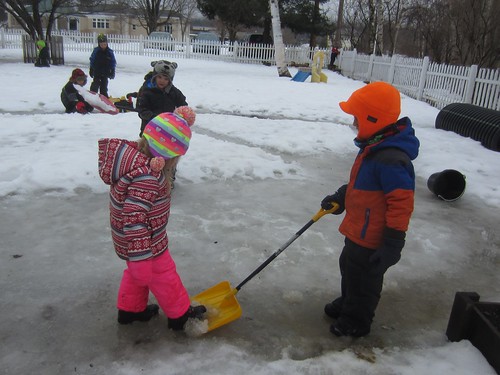



 Gerry Scott came to read to us on Monday morning. It was great to see her, as it has been a while since she has been able to visit. She read us the story Little White Rabbit, by Kevin Henkes, about a rabbit who imagines what it would be like to be different colors, sizes, animals or do things such as fly. The one thing little white rabbit never has to wonder about is how it feels to be loved, because he already knows that!
Gerry Scott came to read to us on Monday morning. It was great to see her, as it has been a while since she has been able to visit. She read us the story Little White Rabbit, by Kevin Henkes, about a rabbit who imagines what it would be like to be different colors, sizes, animals or do things such as fly. The one thing little white rabbit never has to wonder about is how it feels to be loved, because he already knows that!
 For Monday art we learned about the vary famous Michelangelo, who was responsible for some of the world’s most exceptional and well known sculptures and paintings, including David, Pieta, and the ceiling of the Sistine chapel. We looked at pictures of some of his paintings and sculptures, including St. Proclus, Madonna of Bruges, and Sybils Erithraea. We took a glimpse at the ceiling of the Sistine Chapel and discussed how he might have done such extensive paintings and some things he would have had to plan for and think about when painting on a ceiling. The children realized that when painting above you, rather than in front of you, you would need to be careful of drips, so we discussed using small amounts of paint. The children quickly got busy creating their own paintings on the ceiling, and some discovered that we also needed to watch our heads!
For Monday art we learned about the vary famous Michelangelo, who was responsible for some of the world’s most exceptional and well known sculptures and paintings, including David, Pieta, and the ceiling of the Sistine chapel. We looked at pictures of some of his paintings and sculptures, including St. Proclus, Madonna of Bruges, and Sybils Erithraea. We took a glimpse at the ceiling of the Sistine Chapel and discussed how he might have done such extensive paintings and some things he would have had to plan for and think about when painting on a ceiling. The children realized that when painting above you, rather than in front of you, you would need to be careful of drips, so we discussed using small amounts of paint. The children quickly got busy creating their own paintings on the ceiling, and some discovered that we also needed to watch our heads!



 Susan introduced us to Pysanky eggs, which are made when wax is very carefully used to draw patterns on an egg, which is then dyed, then more wax is used to draw, and the egg is dyed again, and this pattern is repeated over and over until several patterns in varied colors are made, creating incredible works of art. We used paper, white crayons, and water color paints rather than real eggs, hot wax, and dyes, but our eggs were beautiful as well.
Susan introduced us to Pysanky eggs, which are made when wax is very carefully used to draw patterns on an egg, which is then dyed, then more wax is used to draw, and the egg is dyed again, and this pattern is repeated over and over until several patterns in varied colors are made, creating incredible works of art. We used paper, white crayons, and water color paints rather than real eggs, hot wax, and dyes, but our eggs were beautiful as well.





 On Tuesday we had a special visitor, Ursula, from Germany. She sang us some wonderful songs in German about birds and a boy who goes to America then returns home to his mother. She showed us pictures of castles in her home town of Coburg, and Hummel figurines made in Germany, which she had collected since she was young. She even brought us a tasty treat of chocolate covered cake. She showed us a photo of the statue of prince Albert, and told us of a movie about prince albert and Queen Victoria. It was a wonderful visit, and we enjoyed meeting Ursula.
On Tuesday we had a special visitor, Ursula, from Germany. She sang us some wonderful songs in German about birds and a boy who goes to America then returns home to his mother. She showed us pictures of castles in her home town of Coburg, and Hummel figurines made in Germany, which she had collected since she was young. She even brought us a tasty treat of chocolate covered cake. She showed us a photo of the statue of prince Albert, and told us of a movie about prince albert and Queen Victoria. It was a wonderful visit, and we enjoyed meeting Ursula.
 We read the story The Great White Man Eating Shark about a boy named Norbert who pretends to be a shark so he can have the swimming cove all to himself, and what happens when he is so good at being a shark. Wolfgang and Henrietta chatted with us afterwards about how the people on the beach were feeling, and what everyone in the class felt about that situation. Everyone agreed that it would be more fun to go swimming with family and friends, except Henrietta, who would really like to have the beach to herself. The children felt that it was unfair to all of the other chickens and people on the beach to not be able to swim.
We read the story The Great White Man Eating Shark about a boy named Norbert who pretends to be a shark so he can have the swimming cove all to himself, and what happens when he is so good at being a shark. Wolfgang and Henrietta chatted with us afterwards about how the people on the beach were feeling, and what everyone in the class felt about that situation. Everyone agreed that it would be more fun to go swimming with family and friends, except Henrietta, who would really like to have the beach to herself. The children felt that it was unfair to all of the other chickens and people on the beach to not be able to swim.




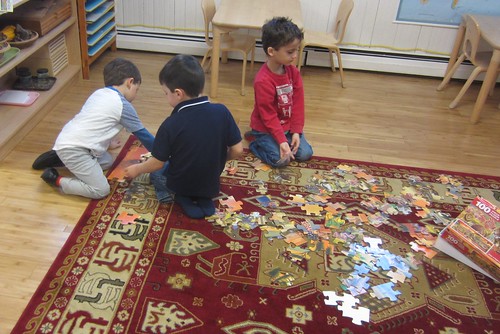
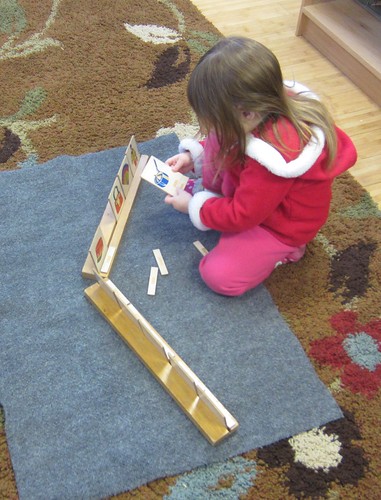
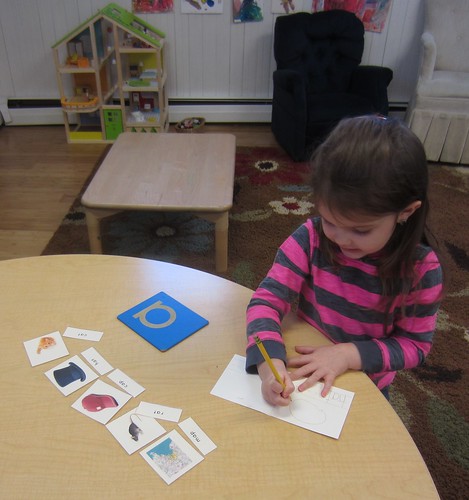




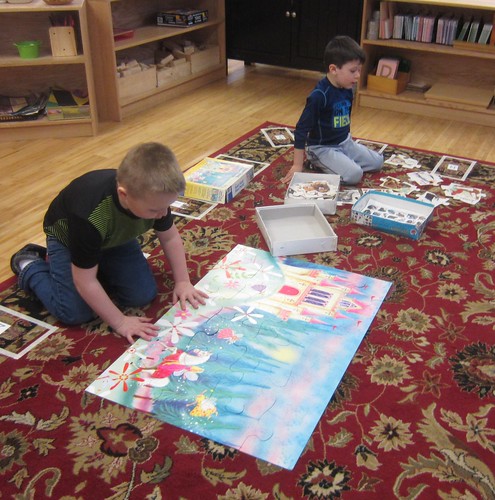



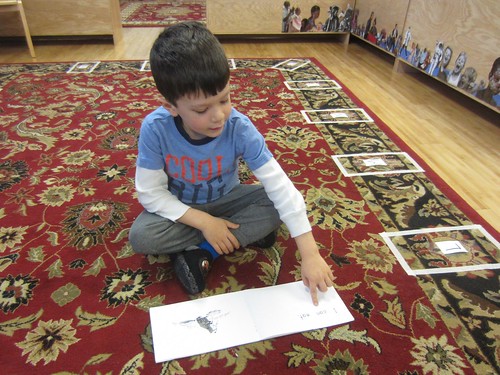







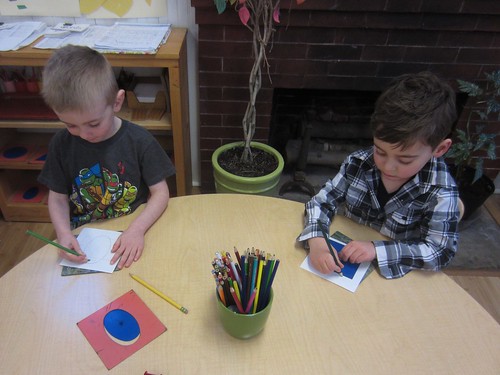
 For science on Friday we continued to learn about the human body. This week we learned about the skeleton and the jobs of the bones in our body. We learned that we are born with more than 300 bones, but as we grow, they start to fuse together, and when we are adults we have 206. We read that their three main jobs are to hold us up (give us our structure), protect our organs, including our brain, spinal cord, heart, and lungs, and to provide a place for muscles to connect. As mammals, we have an endoskeleton, which is inside our body, unlike insects, arthropods, and crustaceans, which have exoskeletons. Each of the children then used Q-tips to make their very own skeleton.
For science on Friday we continued to learn about the human body. This week we learned about the skeleton and the jobs of the bones in our body. We learned that we are born with more than 300 bones, but as we grow, they start to fuse together, and when we are adults we have 206. We read that their three main jobs are to hold us up (give us our structure), protect our organs, including our brain, spinal cord, heart, and lungs, and to provide a place for muscles to connect. As mammals, we have an endoskeleton, which is inside our body, unlike insects, arthropods, and crustaceans, which have exoskeletons. Each of the children then used Q-tips to make their very own skeleton.
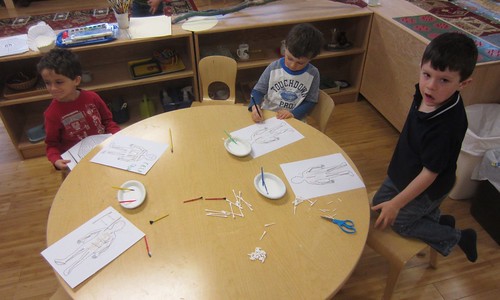
Wonders
April 1, 2017
